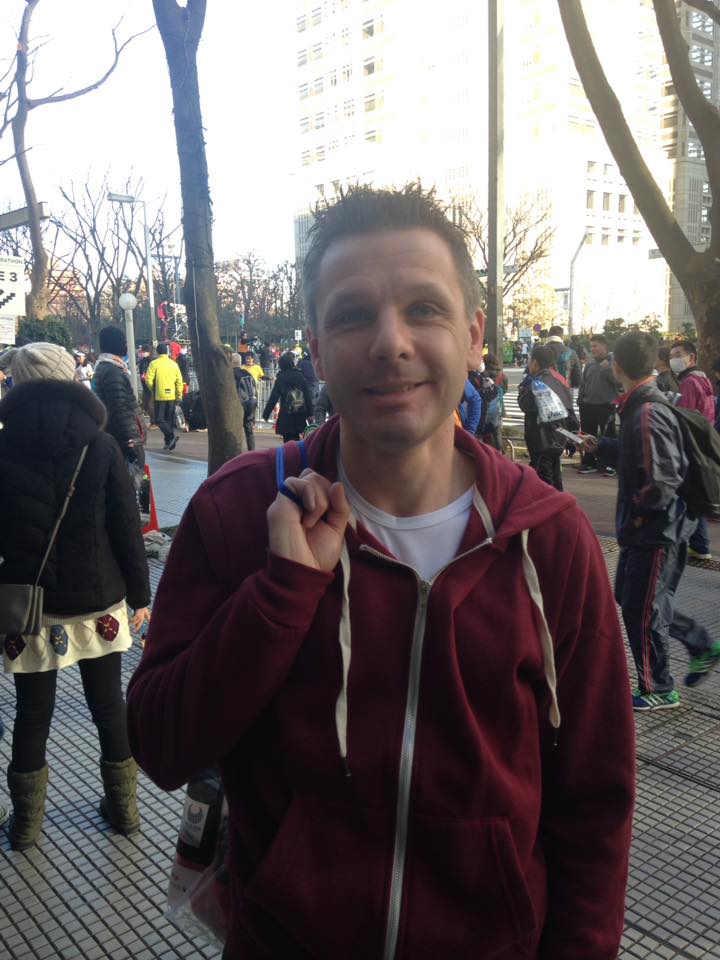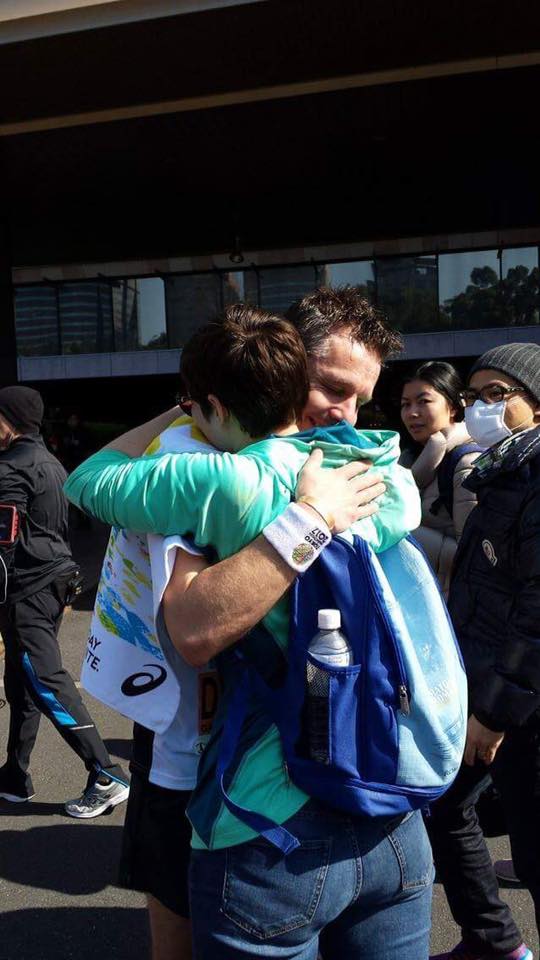By rights, I probably shouldn’t be writing this race report.
In October last year after a flight to San Francisco a small vein started to protrude on the outside of my right calf, which I presumed was a varicose vein and decided to get seen once I got back from holiday. Meantime I continued to do my 20 and 22 milers in the Bay sunshine and even finish first veteran in the Bridge to Bridge 5k as part of my training for the New York Marathon, all the time completely oblivious to what was going on in my leg. The day after returning I saw the GP for what I assumed would be a routine referral and ended up being rushed to A&E for ultrasounds, x-rays and blood tests to diagnose a Deep Vein Thrombosis just below my right knee. Suddenly everything comes crashing down, you have no idea what this means for your future and you start feeling very, very mortal. New York was obviously out of the question given the potential consequences of another trans-Atlantic flight but as it hadn’t been causing me pain whilst running, I asked the consultant if I could start running again in some form perhaps in a week or two and was given the ok with the proviso to take it very easy and not to cut myself, as I was going to be on anti-coagulants for the next six months.
That night was spent scaring myself silly on Google, feeling sorry for myself and trying to work out how this was going to potentially affect my life. Next day there were still a hundred thoughts racing through my head but the one thing that usually helps me to clear my mind is to go for a run. So after a long debate with myself I decided that I was going to go to the track and even if it was slow, I was going to run. That decision was probably what got me to Tokyo - if I had left it even until the weekend then it would have festered in my mind and I wouldn’t have run for months. I made it round, nowhere near my normal pace, but it removed at least some of the demons in my mind. The first Sunday League cross-country was due that weekend and having committed to going I went through with what felt like the scariest race of my life. Every step was terrifying - worrying whether that jolt on the uneven surface was going to dislodge the blood clot, am I going to trip on the tree roots and dislodge the clot, am I going to get spiked and not stop bleeding. By the end, my brain was scrambled but I’d done it and was still in one piece which provided a real confidence boost.
The medication was starting to kick in and leaving me constantly tired so I didn’t run until the following weekend and, tiring badly towards the end of the run, ended up tripping, falling, giving myself a badly cut knee and draining all my confidence. It turns out I’d even lost out on the worst Thrombophlebitis contest to Jenny Baker. Back to square one and I didn’t run for a week but knew if I wanted to have any chance of making Tokyo I needed to start training in two weeks, so after giving myself another talking to I managed to force myself out to do a midweek run and cross country at the weekend to prove to myself I could at least run twice a week. Going through my plan with Mirka we decided to take the New York plan and remove the easy and recovery runs and have complete days off instead; the medication was leaving me finishing my runs with a face greyer than Aberdeen granite and not up to running two days in a row, but if I could at least do three sessions in a week I could get to the start line in some sort of shape.
So, week one, session one and a spectacular “heid o’er arse” fall on the track at Perivale cutting hands, elbows and knees - its amazing that as soon as someone tells you not to do something it suddenly becomes all you can seem to do (the track trip was later followed by a comedic slow motion fall on black ice in Aberdeen during a long run at Christmas to cut the other knee). However, this time I didn’t let it shake me and I kept up with the sessions - the pace wasn’t quite there but the stubbornness was and I was getting there. A few weeks later and the recoveries were getting easier – the next test was to try back to back days with a cameo at the Wormwood Scrubs Met League on the Saturday followed by the Perivale 5 on the Sunday. Another test passed and so by the end of December I’d managed to step up to 4 runs a week and was allowing myself to think that maybe under four hours was possible, and not just reaching the start.
Through January my pace gradually picked up and midway through I had a check-up with the consultant which confirmed that the clot had gone and I’d be safe to fly. I was going to make it to the start line and the training was going better than expected – maybe a PB was in reach. The extra run each week was making a difference and the less running early on seemed to have left me a bit fresher for the last few weeks before February’s taper. Ironically, after six previous attempts, the one where I started with DVT was the first one I’ve finished my training uninjured.
And so to the sensory overload that is downtown Tokyo - neon lights, huge video screens on every street corner booming out music and adverts and, of course, lots and lots of people. This meant that on race day you were never quite sure if you were being cheered on by spectators and on-course entertainment or listening to the Japanese X Factor winner and being sold car insurance.
We headed to the Expo on the first evening and although the content was pretty much the same as any other what was noticeable was the overwhelming friendliness of the volunteers. I’m not sure if this was just because I was an overseas runner but I was greeted by almost every volunteer and thanked profusely for coming to visit their city and run in their marathon.
Saturday was the Friendship Run which Angela and Ellen took part in and I’m sure will be the subject of a Duffrunning blog so won’t go into details here. It did however introduce us to the official sports drink of the marathon “Pocari Sweat” which as well as having an unfortunate name, has the rather unappetising tagline of “having the appropriate density and electrolytes, close to human body fluid”. Having made a mental note to stick to water next day, the rest of the day was spent taking it easy and carb loading on the oatcakes and Jaffa Cakes I’d managed to smuggle into the country.
Race day dawned and with the hotel being only a few hundred metres from the start line I figured I had plenty of time, but the starting area was chaos with understaffed security checks just to get in, baggage lorries at the opposite end to the entry gate I was given and less toilets than the Ealing Half for over 36,000 runners. Having finally managed to drop my bag and given up any hope of getting to the loos I ended up getting into my start pen with only a minute to spare which left me a bit flustered and it took a bit of time to get my focus back on the task in hand. My ethos of “just making the start line is a result” was being severely tested but after the struggle to get here I was determined to stay relaxed and enjoy the race regardless of what happened.
The start itself was fairly low-key – a quick introduction of the elite runners, a confetti cannon and then we were off. Maybe it was because I was starting a bit further up the pack but, compared to London, the field started to move fairly quickly and I managed to get into my running within the first couple of hundred metres. Unfortunately, the first two kilometres also seem to be the Tokyo equivalent of Canary Wharf with satellite reception going haywire and showing me having a quick jog up to the 12th floor of one of the nearby skyscrapers before getting on with the race, so my distances were already about 300m too long by the time I passed the 2km marker. After that, the markers seemed to be pretty much spot on and it was nice to have the course measured in kilometres for a change as I do all my training in kilometres (miles are too far).
The toilet stops were frequent and well signposted with service station style signs telling you the distance to the next stop as well so you can plan if you can make it to the next one, meaning I didn’t lose too much time making up for not managing to go pre-race and by 8k I was pretty much back on my target pace. The water stations were also very regular with plenty of tables at each to avoid too much of a scramble although I did walk through them to avoid throwing most of the cup over myself.
At 10k you start the first of the three out and back sections that make up the rest of the course which gave the chance to see the leading wheelchair racers coming back the other way. The out section takes you to 15k and the turning point probably sums up the city perfectly – you run toward the almost 400 year old Kaminarimon Gate at Senso-ji Temple (the one with the huge paper lanterns) and then turn right to be confronted by the 4 year old Skytree Tower.
Almost from the start the crowd was really supportive but not as overbearing as London can be, and they seemed to be picking out the international runners for additional shouts of encouragement which I found a real help in keeping me relaxed and enjoying the race. I even managed to Eagle for the camera. A glance at my watch showed I’d nudged slightly ahead of pace at 15k and I was still feeling good – so far so good.
From 16k you follow another out and back through halfway and up to 25k. The elite runners had long since passed but there was a steady stream of sub-3 hour runners coming the other way. At 20k my pace had picked up again slightly and then again at 25k – I was going to pay for this sooner or later. By this point the temperature had started to edge up and after spending the majority of my training in temperatures hovering around freezing the sudden jump to the mid-teens was not particularly welcome, so although the crowds thin out between 25 and 30k the skyscrapers lining the route were providing a useful sunblock. Another 5k checkpoint and my pace had picked up again – surely I couldn’t keep this going?
30k onwards is the final and toughest out and back – just over 5k straight into a strong headwind and slightly uphill all the way but the crowds are back and pushing you along before turning for the long run home. For those towards the back of the pack I could see this stretch being a bit soul destroying as the crowds drift away and there are fewer and fewer runners on the opposite side of the road. I manage to keep pushing my pace along and reach 35k with a bit of a cushion to 3:30. This was getting into uncharted territory – I’ve never managed to run beyond 23 miles in a marathon. I kept thinking the wheels must come off soon but I reached 40k still running and increasing my pace. Things were twinging but nothing serious.
Then at 41k, just as I entered the last stretch to the finish, my hamstring pulled slightly and I stopped to walk just as the crowd was building and the noise increasing – sod it, I thought. I’ve got less than 5 minutes, I can run this. I broke into a run again.
The last kilometre gets noisier and noisier until the final corner and then…..well, nothing. An empty plaza that leaves you wondering if you took a wrong turn then you eventually spot a timing mat and a small race clock to confirm that, yes, this is actually the finish line. Despite the underwhelming finish area I raised my arms in celebration and relief at finally breaking 3:30, crossing the line in 3:27:45.
This was the point where Tokyo really let itself down. There was no water at the finish. Or round the corner from the finish. Or for another kilometre. They seemed to have gone out of their way to stretch out the finishing zone as far as possible before giving you anything to drink and even then it’s genetically engineered Sweat. Then you receive your medal and a finisher’s towel which is really nice and something different to the usual finishing line goodies. Eventually you receive a bag with water in it but then have another kilometre to walk to pick up your bag, although the guard of honour that Tom mentioned was still going strong when I got there. I suspect they were still going strong for those coming in at 6 and 7 hours because the volunteers across the weekend all just seemed so insanely polite, happy to be there and genuinely pleased to see you. Once I had my bag it was off to the meeting point to be reunited with Angela. Oh – that’s right, there’s no meeting point. After a few texts and descriptions of buildings we eventually managed to all meet up.
As Tom mentioned, it’s a relatively new race and they are still sorting themselves out year by year. None of the little gripes need big or difficult fixes – a few banks of urinals in the start area would halve the toilet queues, using some of the acres of space at the finish line to store crates of water, squashing up the finishing zone to half the length and a few poles with letters on in Hibiya park to act as a meeting point are all easily done and I’m sure the race will continue to grow and improve.
Despite the issues at the start and finish I loved the race itself and credit to all the volunteers along the way for making the event.
Wilson Kipsang may have won but he didn’t get a PB so I’ve got one up on him there.




